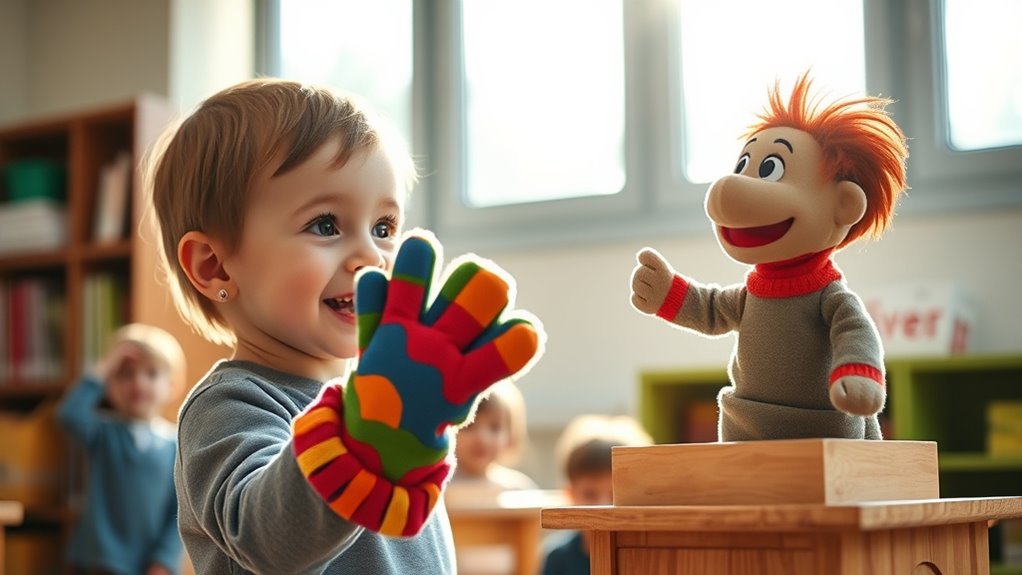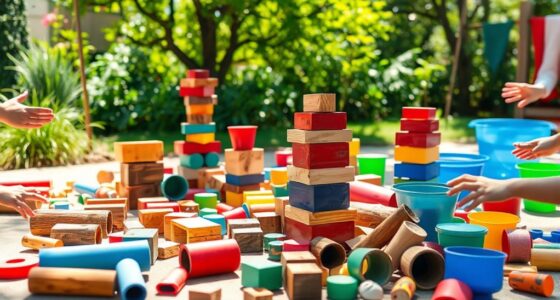Puppet play is a great way to boost your communication skills by encouraging creative storytelling and expressive performance. As you manipulate puppets, you’ll develop confidence in expressing ideas clearly, use body language effectively, and connect with your audience emotionally. Crafting and controlling puppets also help you understand non-verbal cues and storytelling techniques. If you keep exploring, you’ll discover more ways puppet play can enhance your ability to communicate more confidently and creatively.
Key Takeaways
- Puppet play encourages expressive storytelling, enhancing verbal and non-verbal communication skills.
- Manipulating puppets improves hand-eye coordination and understanding of body language.
- Creating and performing with puppets builds confidence and articulates ideas more effectively.
- Engaging with puppet characters fosters empathy and emotional expression in social interactions.
- The collaborative nature of puppet play promotes active listening and team communication skills.

Puppet play is a mesmerizing form of entertainment that brings stories to life through handcrafted figures and imaginative performances. When you immerse yourself in puppet play, you quickly discover that storytelling techniques are at the heart of captivating audiences. You learn to use voice modulation, timing, and expressive gestures to give your puppet personality and emotion. These techniques help you communicate more effectively, making your stories memorable and engaging. As you develop your skills, you’ll find that storytelling techniques become a crucial part of your toolbox, allowing you to hold attention and evoke empathy from your audience.
Central to puppet play is puppet construction, which involves creating the puppets themselves. When you build your own puppets, you’re not just making figures—you’re designing characters with unique personalities. This process encourages you to think about the character’s appearance, movements, and voice, which all contribute to a richer storytelling experience. You might start with simple sock puppets or move on to more complex marionettes or hand puppets, depending on your interest and skill level. The act of puppet construction also fosters creativity and patience, as you choose materials, craft movements, and fine-tune your puppet’s features. The more effort you put into building your puppets, the more connected you’ll feel to your characters, making your performances more authentic.
Building your own puppets deepens character connection and enhances storytelling authenticity.
As you become more comfortable with puppet construction, you’ll notice how it enhances your storytelling techniques. For example, a well-made puppet can convey subtle emotions through movements and expressions, adding depth to your narration. You learn to manipulate your puppet so that it mimics real-life gestures, which helps the audience connect emotionally. Additionally, constructing diverse puppets allows you to explore different character types, voices, and styles, broadening your storytelling repertoire. Over time, you may experiment with different materials and construction methods, learning which techniques work best for your storytelling style. Incorporating water requirements and proper watering techniques can also ensure your puppets or props are well-maintained if they include live plants or natural elements.
Engaging in puppet construction also improves your non-verbal communication skills. You learn to use your hands and body language effectively, which is essential when performing without words or when emphasizing certain parts of your story. The tactile experience of building puppets gives you a better understanding of movement and mechanics, making your performances more fluid and natural. As your skills grow, you’ll find that puppet play becomes a dynamic way to develop confidence, enhance your ability to express ideas clearly, and connect with others through shared stories. Ultimately, combining storytelling techniques with craftsmanship creates a powerful tool to develop your communication skills in an engaging and enjoyable way.
Frequently Asked Questions
What Age Is Best for Starting Puppet Play Activities?
You can start puppet play activities as early as age 12 months, when children begin to engage in play-based learning. At this stage, age-appropriate puppets help foster communication skills, creativity, and social interaction. As they grow, you can introduce more complex puppets to challenge their developing language abilities. Puppet play is a versatile tool that supports early development and keeps children engaged while learning essential communication skills.
How Can I Incorporate Puppet Play Into Speech Therapy?
Imagine a colorful puppet stage where your child’s voice comes alive. You can incorporate puppet play into speech therapy by using storytelling techniques with puppets to encourage expressive language. As your child manipulates a puppet, they practice emotional expression and narration, making communication fun and engaging. This visual and interactive approach boosts their confidence, helping them develop clearer speech and better social skills while enjoying the creative process.
What Materials Are Safest for Homemade Puppets?
When making homemade puppets, you want to prioritize fabric safety and use non-toxic materials. Choose soft, washable fabrics like cotton or felt, ensuring they’re free from harmful dyes or chemicals. Avoid glues or paints with strong fumes, and opt for non-toxic, child-safe adhesives if needed. By selecting safe, non-toxic materials, you create a secure environment for children to explore and develop their communication skills through puppet play.
How Do I Encourage Shy Children to Participate?
To encourage shy children to participate, focus on trust building and confidence boosting. You can start by creating a welcoming environment where they feel safe to express themselves. Use gentle encouragement, praise their efforts, and give them small, manageable tasks. Incorporate activities that suit their comfort level, such as simple puppet interactions. Over time, these strategies help shy children feel more secure, enabling them to engage more actively and confidently.
Are There Specific Puppet Styles That Enhance Communication Skills?
Imagine your puppet as a mirror of emotion—its design and expressive techniques unlock hidden voices. You should choose puppet styles with vivid features and flexible movements, like hand or rod puppets, to enhance communication. These styles allow shy children to project their feelings more comfortably, turning silent moments into lively conversations. By selecting puppets that invite expression, you create a safe space for kids to develop their communication skills naturally and confidently.
Conclusion
Imagine a young child holding a puppet, eyes wide with wonder as they speak for the first time. Just like that puppet brings stories to life, your child’s communication skills blossom through puppet play. It’s a powerful tool that transforms shy whispers into confident voices, turning learning into an exciting adventure. With each puppet show, you’re nurturing a future filled with words, stories, and connections—building a foundation that will support their growth for years to come.











